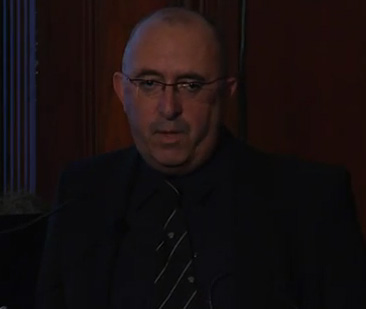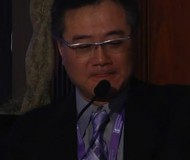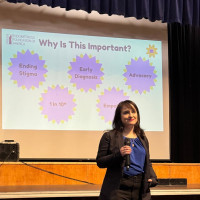Endometriosis Foundation of America
Medical Conference – 2012
Endometriosis : Causes, Symptoms, Diagnosis, and Treatment
Antonio Setubal, MD (2)
Basically the reason you have only 30 percent of results would depend at that time on the camera. If you do not have a good camera at that time, it is impossible to see.
So let us talk a little bit about something that usually we never discuss when we are in the congresses related to endometriosis. When you talk about endometriosis we usually talk about…young people they try to maintain their fertility so we are not going to talk about hysterectomy but sometimes I think we have to talk about the limits of our surgery. Even in younger patients we have to talk about when to decide to do surgery, radical surgery, which means that if you go into the up-to-date total hysterectomy with BSO is the definitive treatment for severe endometriosis. But the question is, should we do it on a regular basis? The answer is NO. Why no, because most of the people are very young people. Socially and culturally they are young and metropolitan. And for women, the DNA of the family is normal, and because there is a professional career for the first years of most of these people, they want to preserve their fertility.
The reason not to perform a hysterectomy is basically fertility. But be aware that the disease is becoming more aggressive and especially as ___ probably will show you the disease is not only becoming more aggressive it is affecting more and more young patients. When you look at things like this and you see - you know the quality of picture here, it is different – so this is a completely frozen pelvis there is nothing yet try to discover where are things, where is the ureter, where are the ovaries…the tubes are here, the rectum is over there, and finally what you are going to have all these dissection…or more difficult like cancer. You get everything exposed, even the rectum over there. These are the ovaries. I have done a salpingectomy, bilateral salpingectomy and at the end we see the results of a huge endometriosis treated by laparoscopy because we will release the ovaries at the end of the operation because the patient needs to go to IVF.
So, what are the questions for a hysterectomy or severe endo? There is some indication that that depends on the patient’s desire. If the family planning is completed and if the symptoms are incapacitating and persist after surgical or medical therapy you will hear women say, “Too much and too many years of suffering”. And because more and more patients are aware of the situation they may have fear of the progression of the disease; this means bowel perforation, this means kidney failure, this probably means cancer and some other things that we can discuss. Beside those two that are related to the patient we have to think about the surgical limits to resection the disease, which means there is the doctor’s indication, the surgical indications that we have to discuss.
Let us discuss something that usually we do not discuss at the endometriosis congresses or courses, or whatever, surgical limit to the resection of the disease and the surgical indications in spite of the age of the patient. So oophorectomy or not there is almost no data about that. The only paper I could find was from 1973 and there is only one study suggesting that a high recurrence rate without BSO only with hysterectomy and there is absolutely no data suggesting there is an increased risk with HRT.
When we are going into the rectum and sigma we have these types of lesions on the rectum and the sigma that can be unifocal or multifocal or something like that, that it looks like a cancer. You want to remove all the bowel so you have to think about how you are going to do it. There is a significant risk of perforation so there is probably a significant risk of peritonitis. The time of perforation is not predictable, nobody can predict if any lesions is going to take six months or ten years, or never in order to do peritonitis. The other think is the lower and the deeper the tumor, the higher the probability for perforation. There is also a great risk for colostomy if it is a very deep tumor, and maybe the colostomy can be definitive. The other thing is the multifocality of the disease that can exist during the surgery. It is easy because in order that you do not just remove 5 cm of the sigma you are going for 10 cm. But the problem is after surgery, and you have a new nodule of endometriosis, so how much lower can we resect that?
Well, at least in the last year starting in Lisbon and Atlanta ___ in AAGL we almost agreed that we should not go to the level of the inferior rectum. So, probably at the end we have to think that even if we have cases like this. What I want to show you is when you have a dissection like this that you still have a tumor here, but this is the vagina, this is the rectum at the level of 3 cm from the anus. You cannot do a resection here because you have to do a colostomy to the patient probably. It is going to be a definite colostomy, because to do a reanastomosis here is going to be very, very tough. What do you do in those situations after you ___ the fertility of the patient? Probably the safe limits to the rectum resection will be 6 to 7 cm from the anus. We tried to agree on that.
What about the bladder? When you get these on the trigone you have the infiltration of the ureter, you have the infiltration of all the trigone, what to do? Are you going to do a radical cystectomy in order to put the ureteral into the ___ and do a poor quality of life for everybody, even for a very young patient? This is one of my patients and I decided in this patient after discussion with her to do a hysterectomy. I could see during eight weeks lots of small amounts of tumor coming into the Foley catheter and I sometimes have to remove the Foley catheter in order to put in another one. So, invasion of the trigone avoid radical cystectomy and talk to the patient and say, “Listen if you want to do a radical cystectomy, this is going to be a hard operation, and a hard operation with a lot of complications, so let’s discuss about hysterectomy and BSO.
About ureteral endometriosis, again, this is another discussion. We always talk about if the endometriosis is extra or intra ureteral but in my opinion this is not important. The important thing is what is happening here? This is a 25-year-old patient trying to get pregnant and we bilateral hydronephrosis because you have here and here a huge lesion of endometriosis. What to do in these cases? In my opinion, it will depend on kidney damage. You have to start thinking about whether you have to do this operation or not. There is no data so you cannot judge based on the experience of other people. Probably, when you have the GFR more (this is wrong) than 20 ml/min, it will be better to remove the disease and avoid the complications of getting the ureter involved and then you have a complication. Then have to do a ___ or do some other kind of complicated surgery and the quality of life of a young patient, again, is going to be compromised for the rest of her life. If you look at this, this patient was with 12 before I operated on the ureter and now she is 17.9, almost 18. I am still following her in order to see if I am going up so we still do not know where the limits are in order to avoid very complicated surgeries ___ endometriosis in young patients and say, “Listen, this is going to be very difficult. You can get this and this and it is better to start to discuss something better”. Usually we never discuss this because they are young patients.
When we talk about the inferior hypogastric plexus again there is another thing that we have to think about. If you have some disease like this, and there are a lot of them, here you see a ureter that was already invaded by the disease. You have to go down because there is a lot of disease on here. I am trying to separate the ureter from the pararectal fossa where you have the disease completely involving the inferior hypogastric plexus. You know you have to remove the disease, so you have to cut and in this case it was unilateral. I took the decision to remove everything around the ureter. There is, I am afraid, damage. Probably you would say there is a little bit of disease over there but I do not know. I prefer to remove a little bit of disease and I will tell you why in a couple of minutes. The key question is trying to avoid the most important stretches and then remove what you have to remove in the involvement of the inferior hypogastric plexus. The reason for that is if you have radical surgery in such situations you are going to have bad complications because you can have a lifetime self catherization of the bladder in a young patient and an absence of orgasm and chronic impairment of defecation.
So, how far should we go with surgery? Again, there are no landmarks so each patient will have a different reaction, even if you do only on one side. We know if we are going in both sides the patient will get everything of this. But even if you go in just one side, like you saw in the film, there are publications already saying that still the patients have complications like this. So, we do not have any limits and we do not have any data. There is no data available for radicality. Again, do we have to think or at least we have to discuss with the patient about HYST plus or not BSO.
Ascitis, this is endometriosis ascitis. What do you have in this case? What do you do? There are no publications of ascitis and endometriotic ascitis with a patient that can be pregnant after that. But believe me, this patient, is pregnant right now for 14 weeks. I am lucky, if she delivers I am going to publish this case because it is as far as I know the first case with endometriosis ascitis that became pregnant after the surgery.
There is, again, no data, there are different results as I told you before. After surgery if there is no fertility, if there is recurrence, again you have to think about HYST with BSO or not.
What about this? What about diaphragmatic endometriosis when you can see the lung through the hole. When you can see…even you can see the heart through the lungs on the diaphragmatic endometriosis. You never know when this patient is going to have hemothorax or anything related to and do…emergency surgery on the lung in order to avoid this. So, you never know when you have to resect that or not. And if the patient asks you, “Doctor, am I going to have any complication with my lung in the future?” you have no answer because you do not know when, like in the bowel, you do not know when it is going to get a perforation. Here you do not know when you are going to have pneumorthorax or hemothorax. When you talk about diaphragmatic endometriosis the risk of lung collapse is unpredictable after pulmonary or combined surgery, laparoscopy with thoracic, no fertility desire and if there is recurrence, you have to think about HYST plus BSO.
What about adenomyosis? That is easy. If there is a diffuse it is different from focal. We do not know the real impact of adenomyosis in infertility because after surgery of severe endometriosis I have a lot of patients that get pregnant, even getting severe adenomyosis. If it is focal probably you can do an adenomyomectomy. If it is diffuse and no fertility after some years and the progression of the symptoms, especially pain and menorrhagia, then again you have to think about HYST plus BSO.
In conclusion, reasons and indications to perform hysterectomy; patient desire again, family planning is completed, that is easy. If there are incapacitating symptoms that persist after surgical or medical therapy, if there is a progressive adenomyosis with pain and menorrhagia and if the patients are aware of the complications of the disease progression on each organ. Again, the clinical surgical judgment on the risks of disease versus specific issues like rectal location is too low, the kidney function, the trigone location, the inferior hypogastric plexus damage and recurrent pneumorthorax and, I can put it here, cancer because there is a relationship because between cancer of the ovary and endometriosis let experienced surgeons on endo make the right decision. Experienced surgeons making decisions is difficult to do because again there is no guideline, there is no data and there are no publications. There are only meetings like this in which we can talk at dinner. Like, “Hey, Harry, I’ve got a patient like this…” or, “I don’t know, David (Redwine) I’ve got a patient like that. What do you suggest?” So, there is nothing except our dinners with a little bit of wine on the menu in the meantime.
Follow and trust the few experts. Thank you very much.










